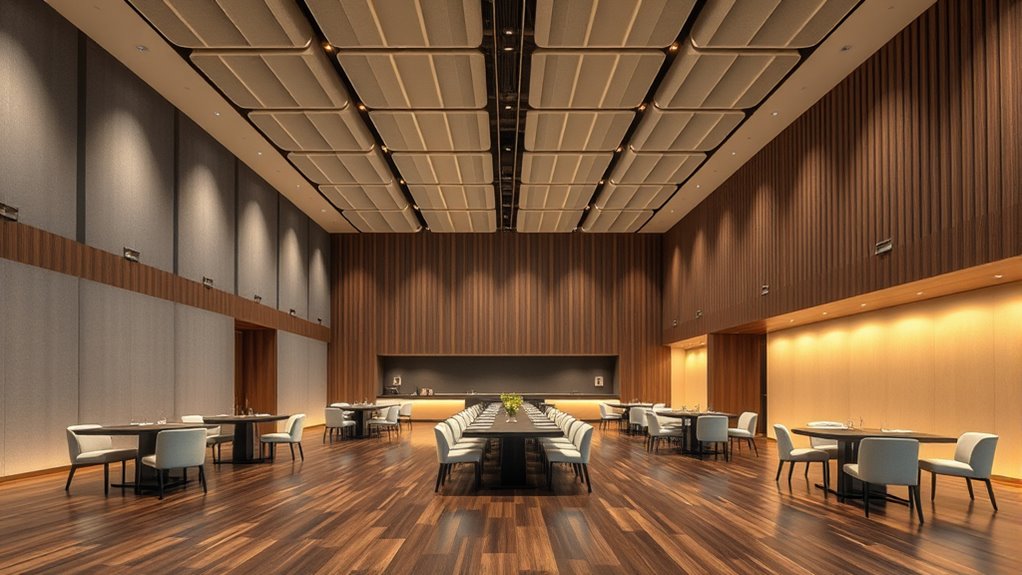To effectively soundproof your open dining hall, start by identifying loud noise sources like conversations and kitchen activity, then incorporate materials such as acoustic panels, ceiling tiles, and sound-absorbing partitions to reduce echo and noise transmission. Use soft textiles, upholstered furniture, and strategic layout changes to dampen sound further. Installing soundproof doors and windows helps block external noise. With ongoing maintenance and thoughtful design tweaks, you can create a quieter, more inviting space — learn more to optimize your environment.
Key Takeaways
- Conduct an acoustic assessment to identify major noise sources and echo-prone areas for targeted soundproofing.
- Install high NRC-rated acoustic panels, fabric-wrapped or perforated designs, strategically on reflective walls and near noisy zones.
- Use sound-absorbing furniture, curtains, and soft decor to naturally dampen ambient noise and improve ambiance.
- Incorporate structural soundproofing elements like soundproof doors, double-glazed windows, and underlay flooring for impact noise reduction.
- Maintain and regularly inspect all acoustic materials and structural barriers to ensure long-term soundproofing effectiveness.
Assessing the Noise Levels and Sources
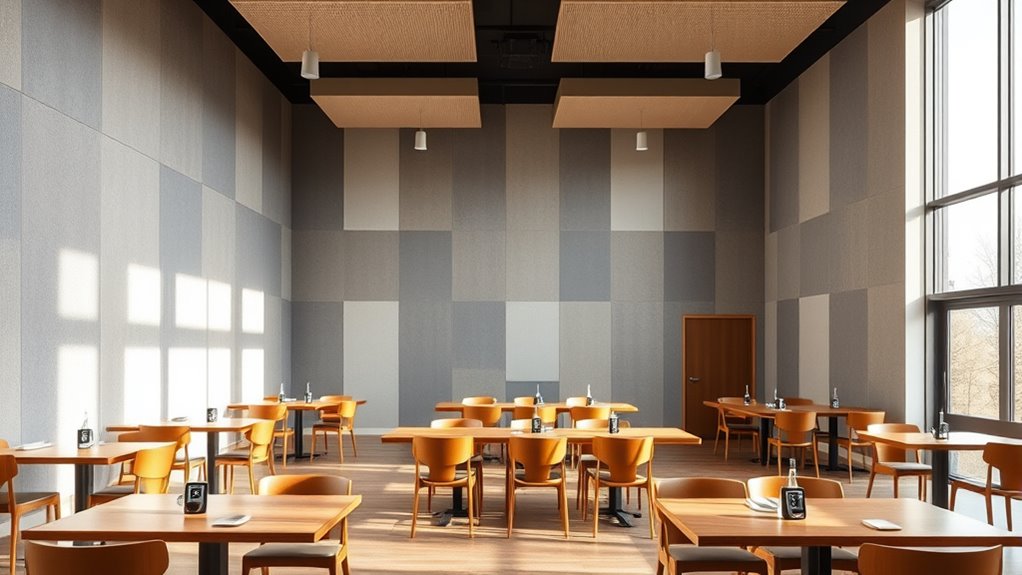
Have you ever wondered what exactly contributes to the noise in an open dining hall? The first step is to identify the main sources. Conversations among diners create constant chatter, especially during busy hours. Clattering dishes, silverware, and glassware add sharp, unpredictable sounds. Background music, if played loudly, amplifies overall noise levels. Structural elements like hard floors, ceilings, and bare walls reflect sound waves, increasing reverberation. Kitchen activities—dishwashing, cooking, or cleaning—generate additional noise that spills into the dining area. To accurately assess these factors, use a sound level meter during peak times. This helps you pinpoint which sources are loudest and where sound echoes most. Understanding the reverberation process can further guide sound absorption strategies. Knowing these details guides effective soundproofing strategies tailored to your specific environment.
Choosing the Right Acoustic Materials
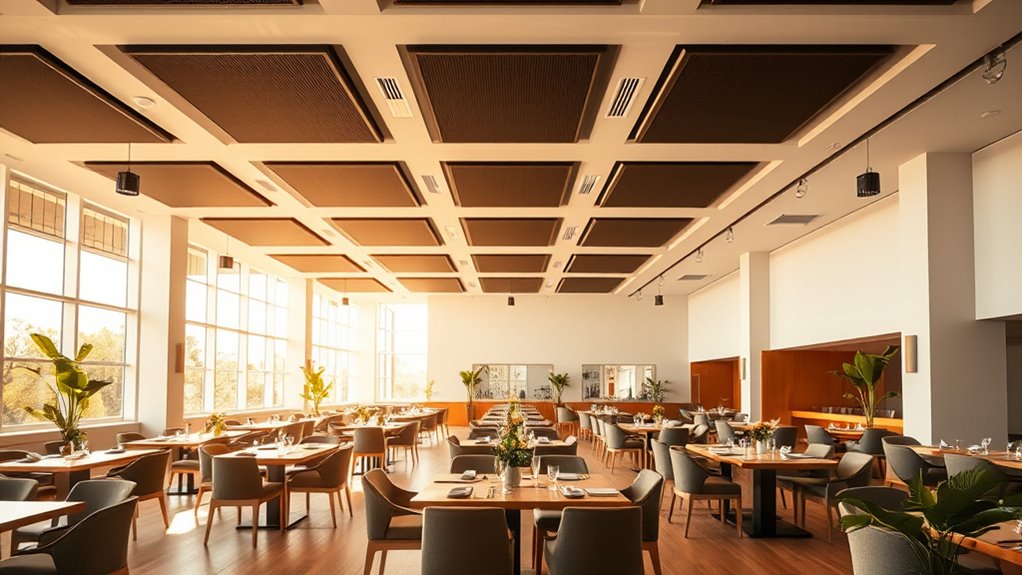
When selecting acoustic materials, you need options that are both effective and durable enough for your dining hall. Consider how the materials will absorb sound while also matching your aesthetic vision. Balancing these factors guarantees long-lasting solutions that keep noise levels comfortable for everyone. Incorporating vetted products designed specifically for commercial spaces can help ensure your choices meet safety and performance standards.
Material Effectiveness and Durability
Choosing the right acoustic materials is essential for guaranteeing both effectiveness and durability in soundproofing open dining halls. You need materials that can withstand constant use, cleaning, and environmental changes without degrading. Look for products with high density and proven long-term performance, such as mineral wool or specialized acoustic panels designed for heavy-duty applications. These materials absorb sound effectively while resisting moisture, mold, and pests. Avoid cheap or flimsy options that may break down or lose their soundproofing qualities over time. Investing in durable materials ensures your soundproofing lasts for years, reducing maintenance costs and disruptions. Additionally, selecting materials that are compatible with sound absorption techniques helps optimize acoustic performance. Remember, the best materials balance strong acoustic performance with resilience, providing both a quieter environment and long-term reliability.
Acoustic Properties and Aesthetics
Selecting the right acoustic materials involves balancing sound absorption with visual appeal, making certain that the dining hall remains inviting while effectively reducing noise. You want materials that blend seamlessly with your decor but still dampen sound effectively. Consider options like fabric-wrapped panels for warmth and style, perforated wood or metal panels for a modern look, or soft, textured ceiling tiles that absorb sound without cluttering the space. These choices help maintain the atmosphere you desire while minimizing noise levels. Prioritize materials that complement your design theme and provide effective sound control. Achieving a harmonious balance between aesthetics and acoustic performance ensures your open dining hall feels welcoming yet comfortable for conversations. Incorporating diverse beach experiences in your material selection can inspire unique and relaxing design elements. Choosing thoughtfully will enhance both the ambiance and functionality of your space.
Installing Acoustic Ceiling Tiles and Baffles
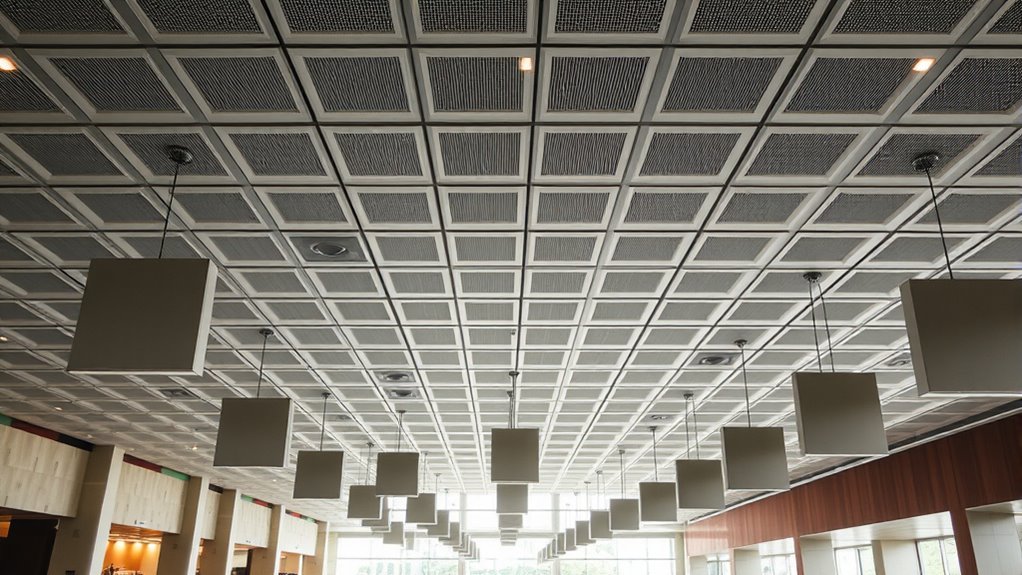
When installing acoustic ceiling tiles and baffles, choosing the right materials is vital for effective sound absorption. You should also consider ideal placement strategies to maximize noise reduction without disrupting the hall’s aesthetics. Additionally, keeping maintenance and durability in mind guarantees your soundproofing solutions stay effective over time. For venues like open dining halls, soundproofing techniques can be further optimized through specialized tuning methods to enhance overall acoustic performance.
Acoustic Tile Materials
Have you considered how acoustic ceiling tiles and baffles can dramatically reduce noise in open dining halls? The materials you choose play a vital role in sound absorption and overall effectiveness. Acoustic tiles come in various compositions, each suited for different needs.
- Mineral fiber: Lightweight, highly sound-absorbent, and fire-resistant.
- Fiberglass: Excellent at dampening echoes, durable, and easy to install.
- Foam: Cost-effective, versatile, but less fire-resistant.
Your choice depends on factors like budget, aesthetics, and safety. Opt for materials with high NRC (Noise Reduction Coefficient) ratings to maximize sound absorption. Selecting the right soundproofing materials can significantly enhance the acoustic comfort in your space, ensuring a quieter, more comfortable dining environment for everyone.
Baffle Placement Strategies
Effective baffle placement is crucial for maximizing sound absorption in open dining halls. To achieve this, hang baffles at different heights and angles to disrupt sound waves effectively. Position them above high-traffic areas and near noise sources like kitchens or open kitchens, where sound tends to bounce and amplify. Space the baffles evenly across the ceiling to create a pattern that promotes even sound absorption. Avoid clustering them too closely, which can reduce their effectiveness. Consider the hall’s dimensions and ceiling height to determine ideal spacing and height. Use adjustable mounting systems if possible, so you can fine-tune their position over time. Proper placement ensures the baffles work together to reduce echoes and improve overall acoustic comfort. Additionally, understanding the acoustic properties of materials can help optimize their sound absorption capabilities for the space.
Maintenance and Durability
Installing acoustic ceiling tiles and baffles requires careful attention to durability and ease of maintenance to guarantee long-lasting performance. You want materials that resist damage and are simple to clean, ensuring your soundproofing remains effective over time. Choose tiles made from high-quality, moisture-resistant materials to prevent mold and deterioration. Regular inspections help catch issues early, like loose tiles or dust buildup, which can compromise sound absorption. Maintenance involves straightforward tasks such as dusting, wiping, or replacing damaged tiles. To maximize longevity, select products with durable finishes and consider sealed edges that prevent debris accumulation. Additionally, selecting sound-absorbing materials that are resistant to wear and environmental factors will enhance the overall durability of your soundproofing solution.
- Use stain- and moisture-resistant materials
- Schedule routine inspections and cleaning
- Opt for easy-to-replace tiles or baffles
Using Wall Treatments to Absorb Sound

Wall treatments are a practical way to absorb sound and reduce noise levels in open dining halls. By installing acoustic panels, you can effectively dampen echo and prevent sound from bouncing off hard surfaces. These panels come in various materials, like foam, fabric-wrapped, or perforated wood, allowing you to choose options that match your decor. Position them strategically on walls where sound tends to reflect most. Additionally, adding textured wall coverings or fabric-covered panels can further absorb noise and create a more comfortable atmosphere. You’ll notice an immediate difference in sound clarity and overall ambiance. Wall treatments are a cost-effective, non-intrusive solution that enhances acoustic comfort without sacrificing style. Proper placement and material selection are key to maximizing their sound-absorbing benefits. Embracing acoustic practice can also help optimize the effectiveness of your soundproofing efforts.
Incorporating Sound-Absorbing Partitions and Dividers
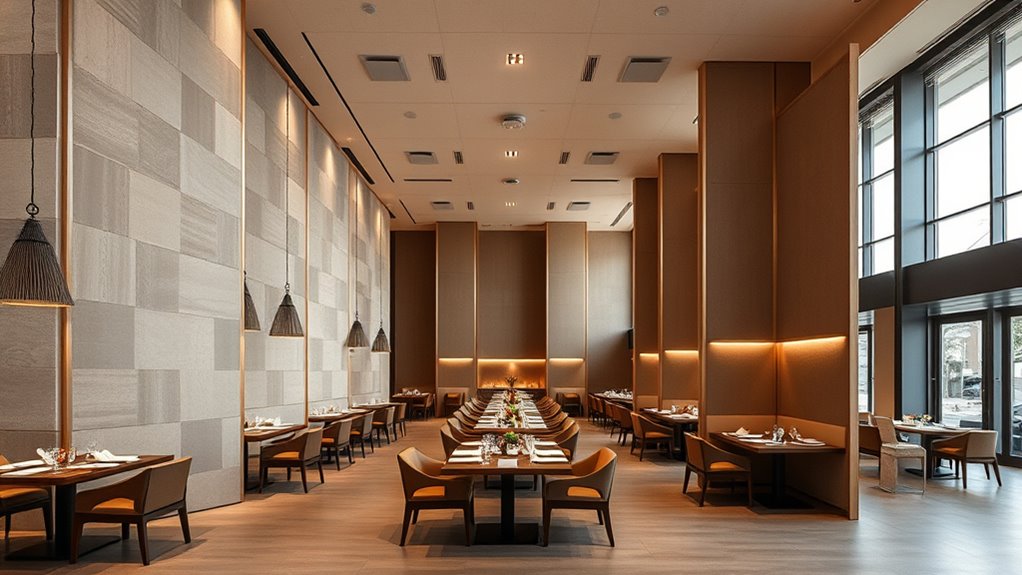
Adding sound-absorbing partitions and dividers within your open dining hall offers a flexible way to manage noise levels while maintaining an inviting atmosphere. These structures help contain sound, preventing it from bouncing around the space and creating chaos. You can choose from various materials like fabric-covered panels, cork dividers, or acoustic foam screens. Positioning these strategically around high-traffic areas or near noisy appliances enhances their effectiveness. They also provide visual separation, giving diners a sense of privacy without sacrificing openness. Additionally, movable partitions allow you to reconfigure the space based on your needs, whether for large groups or intimate gatherings. Incorporating these dividers is a practical, versatile solution that improves acoustics while preserving a welcoming environment. Using sound-absorbing materials can further enhance noise reduction and comfort in your space.
Enhancing Floor Soundproofing Techniques

Choosing the right underlay material can substantially reduce noise transmission through the floor. Placing carpets and rugs strategically helps absorb sound and minimizes footfall noise. Consider these options carefully to create a quieter, more comfortable dining environment.
Underlay Material Selection
Have you considered how underlay material can considerably improve the soundproofing of your open dining hall? Choosing the right underlay can absorb impact noise, reduce foot traffic sounds, and prevent sound transfer to adjacent spaces. When selecting underlay, focus on materials that offer high density and elasticity.
- Mass-loaded vinyl provides excellent sound blocking due to its density.
- Rubber underlay offers durability and absorbs impact vibrations effectively.
- Acoustic foam minimizes airborne noise and echoes within the space.
Ensure the underlay is compatible with your flooring type and installation method. Proper installation plays a crucial role in maximizing soundproofing benefits. A well-chosen underlay creates a quieter, more comfortable environment for diners and staff alike.
Carpet and Rug Placement
To effectively enhance soundproofing in your open dining hall, strategic placement of carpets and rugs can make a significant difference. Start by choosing thick, dense carpets or rugs that absorb sound rather than reflect it. Position these under high-traffic areas, such as near entrances and seating clusters, to dampen footstep noise. Layering rugs in zones where noise tends to concentrate can further reduce sound transmission. Guarantee the rugs cover enough surface area to prevent sound from bouncing off hard floors. Using non-slip pads underneath will keep them secure and prevent additional noise from shifting. Regularly cleaning and maintaining these rugs also preserves their sound-absorbing qualities. Proper placement transforms your space into a quieter, more comfortable environment for diners.
Strategic Furniture Placement for Noise Reduction
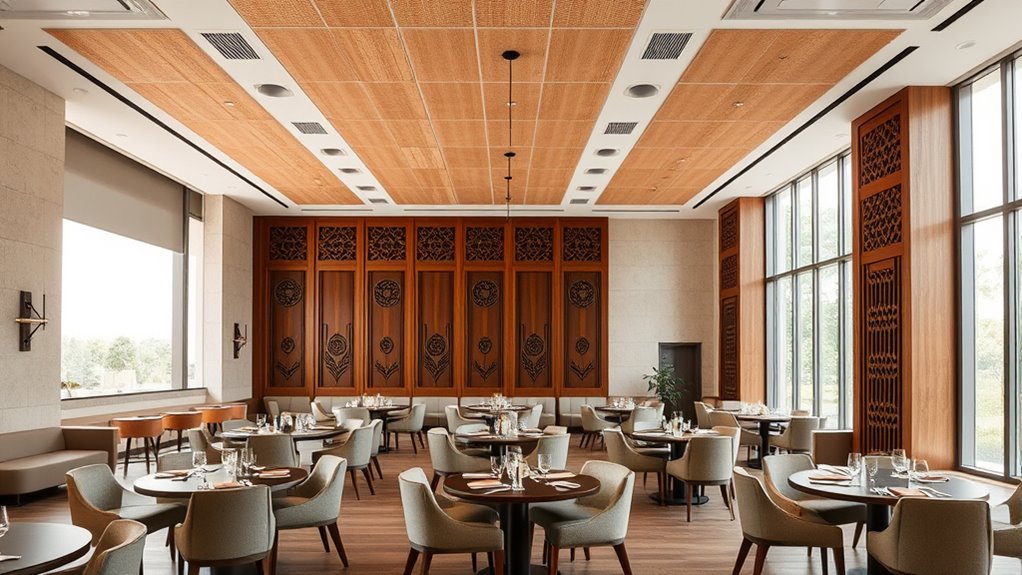
Strategic furniture placement can substantially reduce noise levels in open dining halls by acting as natural sound barriers. Carefully arranging tables, chairs, and partitions helps contain sound and prevent it from bouncing around the space. Position larger pieces of furniture, like booths or high-backed chairs, near noisy areas to absorb sound before it spreads. Use clusters of tables to create zones that dampen noise and define separate dining sections. Additionally, placing furniture against walls can block sound reflections and minimize echoes.
- Place tall or upholstered furniture to absorb sound waves
- Group tables to create sound-buffer zones
- Use furniture arrangements to direct sound away from quiet areas
Implementing Soft Textiles and Upholstery
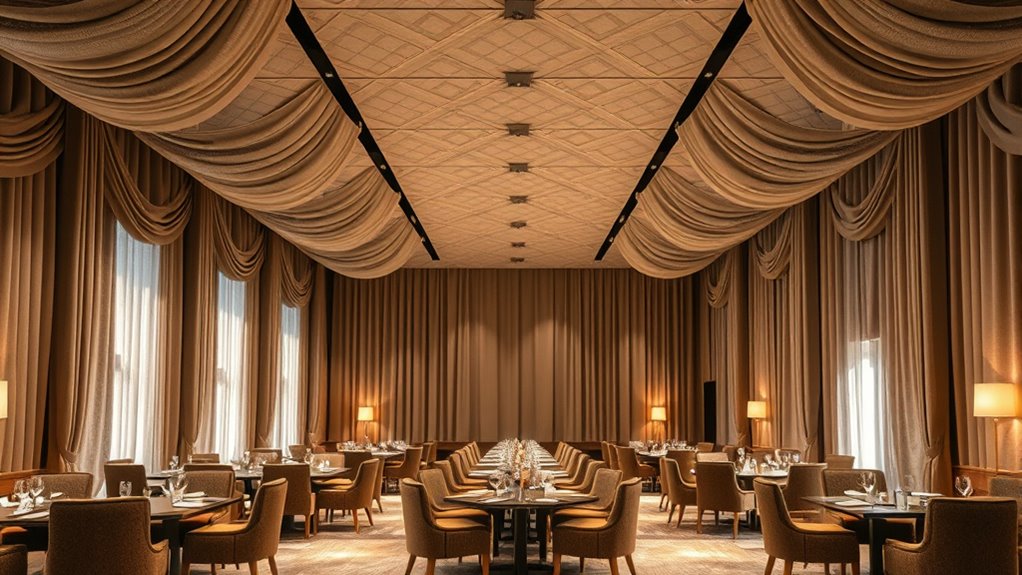
Building on the benefits of furniture placement, incorporating soft textiles and upholstery can considerably enhance noise absorption in open dining halls. You can start by adding upholstered chairs and booths, which help dampen sound waves rather than bounce them around. Use fabric-covered cushions, curtains, and tablecloths to absorb ambient noise, making conversations clearer. Soft wall hangings and acoustic panels with fabric coverings also contribute without cluttering the space. When selecting textiles, prioritize thicker, plush materials that trap sound more effectively. Remember, the goal is to reduce echo and overall noise levels, creating a more comfortable environment. By thoughtfully integrating these textiles and upholstery, you’ll markedly improve acoustics, making the dining experience more pleasant for everyone.
Installing Soundproof Doors and Windows

Installing soundproof doors and windows is one of the most effective ways to block noise from entering or escaping your open dining hall. High-quality, insulated doors can markedly reduce sound transmission, keeping noise levels in check. Choose doors with acoustic seals and thick materials to enhance soundproofing. Similarly, installing double- or triple-glazed windows helps minimize external noise and prevents sound leakage. Proper installation ensures there are no gaps or leaks, maximizing their effectiveness.
- Select doors and windows specifically designed for soundproofing
- Use weatherstripping and seals around frames for a tight fit
- Consider acoustic curtains or secondary glazing for added insulation
Regular Maintenance and Monitoring of Soundproofing Measures

Regular maintenance and monitoring are essential to guarantee your soundproofing measures remain effective over time. You should regularly inspect doors, windows, and barriers for damage, wear, or gaps that could compromise soundproofing. Clean surfaces and seals to ensure they function properly and replace any worn or damaged components promptly. Keep an ear out for increased noise levels, which may indicate deteriorating soundproofing. Periodically assess the effectiveness of your measures by comparing noise levels before and after maintenance. Record these findings to identify patterns or recurring issues. By staying proactive with inspections and repairs, you ensure your open dining hall stays quiet and comfortable, preserving the ambiance for your guests and maintaining the integrity of your soundproofing investments.
Frequently Asked Questions
How Do I Measure the Effectiveness of Soundproofing in My Dining Hall?
You measure the effectiveness of soundproofing by comparing noise levels before and after installation. Use a decibel meter placed at key points to record baseline sounds, then measure again once your soundproofing is in place. If the readings drop markedly, your efforts are working. Also, consider gathering feedback from diners about their acoustic experience. Consistent, lower noise levels indicate successful soundproofing.
What Are the Most Cost-Effective Soundproofing Options for Large Spaces?
Imagine turning down the volume in a bustling room—cost-effective solutions can do just that. You should consider installing acoustic panels, which absorb sound without breaking the bank, or hanging heavy curtains to dampen noise. Carpeted floors and upholstered furniture also help. These options act like a quiet river flowing through your space, making it more peaceful without draining your budget, and are perfect for large, open areas.
Can Soundproofing Affect the Overall Ambiance and Aesthetics of the Hall?
Soundproofing can influence the ambiance and aesthetics of a hall, but it doesn’t have to detract from them. You can choose materials that blend seamlessly with your decor, like decorative panels or stylish curtains. By selecting options that complement your design, you maintain a welcoming atmosphere while reducing noise. Thoughtful soundproofing enhances comfort without sacrificing the hall’s visual appeal, creating an inviting space for everyone.
How Often Should Soundproofing Materials Be Inspected or Replaced?
Think of soundproofing as the silent guardian of your space, quietly working behind the scenes. You should inspect your materials at least once a year, checking for wear, tears, or deterioration. Replace any damaged sections promptly to maintain their protective barrier. Regular maintenance keeps your environment serene and prevents small issues from snowballing into costly repairs, ensuring your space remains a peaceful refuge where conversations flow without interruption.
Are There Eco-Friendly Soundproofing Solutions Suitable for Open Dining Areas?
When you’re looking for eco-friendly soundproofing solutions, you should consider options like recycled cotton, cellulose, or cork, which are sustainable and effective. These materials absorb sound naturally and have minimal environmental impact. You can install them as panels or insulation to reduce noise. Make sure to choose products certified for eco-friendliness, and consult with suppliers to find the best sustainable options for your open dining area.
Conclusion
Think of your dining hall as a symphony—you want each note clear, not drowned out by noise. By applying these soundproofing tips, you’ll create a peaceful oasis where conversations flow effortlessly. One restaurant owner told me their noisy space felt like a playground—until they installed acoustic panels, turning chaos into calm. With some strategic effort, you can transform your open dining hall into a serene spot where every word resonates perfectly.
